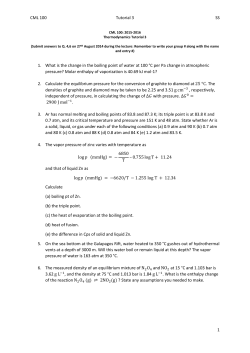
ap unit 11 redox answers
Name__________________________________period_______________AP chemistry 1. Find the oxidation number for each atom in the following a. H2 b. H2O c. HNO3 0 +1 -2 +1 +5 -2 f. MgO +2 -2 k. H2S +1 -2 g. Al2O3 +3 -2 l. Cl2 0 d. SO4 2+6 -2 e. Al 0 h. O2 i. ClO3- j. Mn2O7 2- 0 +5 -2 +6 -2 n. PO4 3+5 -2 o. ClO2 +4 -2 m. Al2O3 +3 -2 Unit 11 worksheet p. SbCl3 +3 -1 2. Arrange the following in order of increasing oxidation number of the xenon atom XeF8-, Xe, XeF2, XeO3, XeF Xe, XeF, XeF2, XeO3, XeF83. What is meant by the term oxidation? Oxidation is when an atom loses electrons 4. In each of the following redox reactions, identify the elements that undergo changes in oxidation number and indicate the magnitude of the change a. I2O5 + 5CO I2 + 5CO2 Iodine changes by 5; Carbon changes by 2 2+ + b. 2Hg + N2H4 2Hg + N2 + 4H Hg by 2; N by 2 c. H2S + 2H+ + 2NO3- 2S + 2NO + 4H2O S by 2; N by 3 5. Of the following reactions, label if they are redox or not. If they are redox, identify what is oxidized and what is reduced. a. 2Na + Cl2 2NaCl yes; sodium is oxidized, chlorine is reduced b. 2 H2O 2 H2 + O2 yes; hydrogen is reduced, oxygen is oxidized c. NaCl + AgNO3 AgCl + NaNO3 no 2+ 2+ d. Cu + Zn Zn + Cu yes; copper is reduced, zinc is oxidized e. I2 + SO32- + H2O 2I- + SO42- + 2HI yes, iodine is reduced, sulfur is oxidized 6. Write the oxidation and the reduction half reaction for each of the following a. Ca + 2H+ Ca2+ + H2 Ca Ca2+ + 2e-; 2H+ + 2e- H2 b. Sn2+ + 2Fe3+ Sn4+ + 2Fe2+ Sn2+ Sn4+ + 2e-; 2Fe3+ + 2e- 2Fe2+ c. Cl2 + 2Br 2Cl + Br2 2Br- Br2 + 2e-; Cl2 + 2e- 2Cl7. Balance the following reactions in acids a. Zn + SO42- Zn2+ + SO2 Zn + 4H+ + SO42- Zn2+ + SO2 + 2H2O b. I2 + OCl- IO3- + ClH2O + I2 + 5OCl- 2IO3- + 5Cl- + 2H+ c. Cr2O72- + I- Cr3+ + IO3Cr2O72- + I- + 8H+ 2 Cr3+ + IO3- + 4H2O d. MnO4- + CH3OH Mn2+ + HCO2H 4MnO4- + 5CH3OH + 12H+4 Mn2+ +5 HCO2H + 11H2O 8. For each of the following incomplete reactions, state whether a redox reaction is likely to occur and complete the rxn. a. Mg + Sn2+ Mg2+ + Sn spontaneous b. Ag + Cu2+ Ag+ + Cu No reaction c. Br2 + I- Br- + I2 spontaneous reaction 9. Are the following reactions spontaneous? a. Cr +3 b. Br +2 + Ni(s) Cr(s) + Ni (aq) 2(l) - + 2I (aq) 2Br c. Cl2(s) + Sn (s) Cl +3 d. Al + Au (s) (aq) (aq) +3 Al (aq) no +I +2 + Sn (aq) 10. a.What is reduced in 9c? (aq) - 2(s) (aq) + Au (s) yes yes yes chlorine b. What is oxidized in 9d? aluminum 11. A. Use the following to deduce the order of reactivity of elements w,x,y,z w + x+ w+ +x y+ + z no reaction w, x, y, z (most likely to be oxidized least likely) x + z+ x+ + z x + y+ x+ + y b. Will the following reactions occur? i. w+ + y w + y+ ii. w + + z w + z+ No No 12. In a voltaic cell, transfer of charge through the external wires occurs by means of (a) ionization (b) ion migration (c) electron migration +2 +3 13. The following questions are about this cell: Pb + Al Pb + Al (d) proton migration a. Identify the anode and the cathode. c. Write the ½ reaction that occurs at the anode anode: Al Cathode: Pb Al Al3+ + 3eb. How do the electrons flow? d. In what direction do the cations flow? From Al to Pb toward Pb solution e. What is the cell voltage? f. In what direction do the anions flow? To Al 1.53 V 14. Calculate the Ecell for each of the following and tell if the reaction is spontaneous or not. a. H2 + I2 2H+ + 2I0.536 V; spontaneous b. Ni + 2Cs+ Ni2+ + 2 Cs -2.67 V; nonspontaneous c. 2Al3+ + 3Cd 2Al + 3Cd2+ -1.26 V; not spontaneous 15. Use the Pb and Zn cell A. Which electrode is the cathode? a. Pb b. Zn c. Neither. B. Which electrode is the anode? a. Pb b. Zn c. Neither. C. At which electrode will oxidation occur? a. Pb b. Zn c. Neither. E. What is the cell voltage? D. At which electrode will reduction occur? 0.63 V a. Pb b. Zn c. Neither E. 0.63 V F. Which way do the electrons flow in the external circuit? a. From Pb to Zn. b. From Zn to Pb. c. No electron flow occurs 16. A voltaic cell utilizes the following reaction: Al + 3 Ag+ Al3+ + 3Ag. What is the effect on the cell voltage for each of the following changes? a. Some aluminum nitrate is added to the anode compartment, increasing the concentration of aluminum ion. Decreases cell voltage b. The size of the aluminum electrode is increased no change c. Additional water is added to the cathode compartment decreases cell voltage d. Sodium nitrate is added to the anode compartment. No change 17. How many seconds will it take to plate out 7.8 grams of zinc from a solution of Zn(NO3)2 using a 23.0 Ampere current? 1000 S 18. A Cr3+ solution is electrolyzed using a current of 9.75 A. What mass of Cr is plated out after 1.50 days? 227 g 19. MnO4–(aq) + H+(aq) + C2O42–(aq) → Mn2+(aq) + H2O(l) + CO2(g). What is the coefficient of H+ when the above reaction is balanced? a. 16 b. 2 c. 8 d. 5 e. 32 20. Zn(s) + Cu2+(1 M) → Cu(s) + Zn2+(1 M). The cell has a voltage that is measured and found to be +1.10 V. a. What happens to the voltage when a saturated ZnSO4 solution is added to the zinc compartment of the cell? decreases b. What happens to the cell voltage when the copper electrode is made smaller? No change c. What happens to the cell voltage when the salt bridge is filled with deionized water instead of 1 M KNO3? Goes to zero d. What happens to the cell voltage after the cell has operated for 10 minutes? Decreases 21. Cr2O72– + 14 H+ +3 S2– → 2 Cr3+ + 3 S + 7 H2O. For the reaction, pick the true statement from the following. a. The S2– is reduced by Cr2O72–. b. The oxidation number of chromium changes from +7 to +3. c. The oxidation number of sulfur remains –2. d. The S2– is oxidized by Cr2O72–. e. The H+ oxidizes the S. 22. Which is more favorable, the reduction of the silver ion or the reduction of the tin(II) ion? silver Review 23. How many protons, neutrons, and electrons are in chlorine-37? 17,20,17 24. A mixture of helium and neon gases has a total pressure of 1.2 atm. If the mixture contains twice as many moles of helium as neon, what is the partial pressure due to neon? a. 0.2 atm b. 0.3 atm c. 0.4 atm d. 0.8 atm e. 0.9 atm 25. Which of the following gases would be expected to have a rate of effusion that is 1/3 as large as that of hydrogen? a. oxygen b. nitrogen c. helium d. water e. carbon dioxide 26. When chlorine gas is combined with fluorine gas, a compound is formed that is 38% chlorine and 62% fluorine . What is the empirical formula of the compound? ClF3 27. Which form of orbital hybridization can form molecules with shapes that are either trigonal pyramidal or tetrahedral? a. sp b. sp2 c. sp3 d. spd e. spd2 28. How many grams of PbSO4 dissolve in 1 L of solution? (PbSO4 Ksp = 1.8 x 10-8 ) 0.041 g 29. A. i. successful molecular collisions must have sufficient energy in order to result in reaction. Only collisions with sufficient energy to overcome the activation energy barrier will be able to reach the transition state and begin to break F-F bonds (must talk about activation energy) ii. For a collision to be successful, the molecules must have correct orientation. Only collisions with the correct orientation will be able to begin to form an N-F bond and begin to break an F-F bond as the transition state is approached. b. The rate law that is consistent with the mechanism is the one on the right above (rate = k[NO2][F2] Step I is the slower step and the rate-determining step in the mechanism. Since step I is an elementary reaction, its rate law is given by the stoichiometry of the reacting molecules, rate = k[NO2][F2] 30. A. 0.701 atm b. 0.14 atm c. 2.2 d. Kpwill increase. According to Le Chatlier’s principle, raising the temperature of an endothermic reaction at equilibrium produces more products so Kp will increase. e. Decrease: Q (1.0)< Kp (2.2) thus the reaction will consume SO2Cl2 as it proceeds in the forward direction toward equilbrium
© Copyright 2025




















